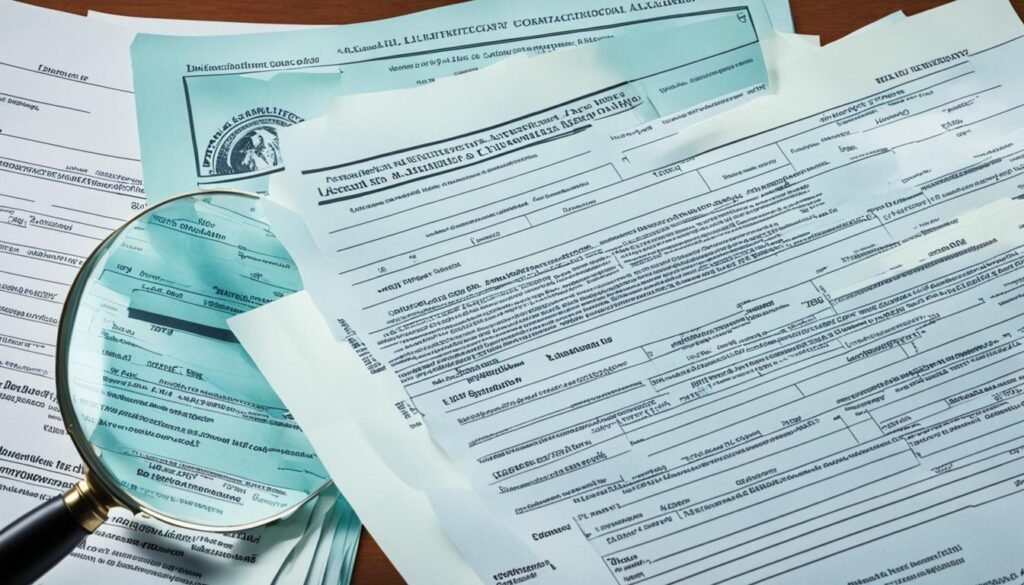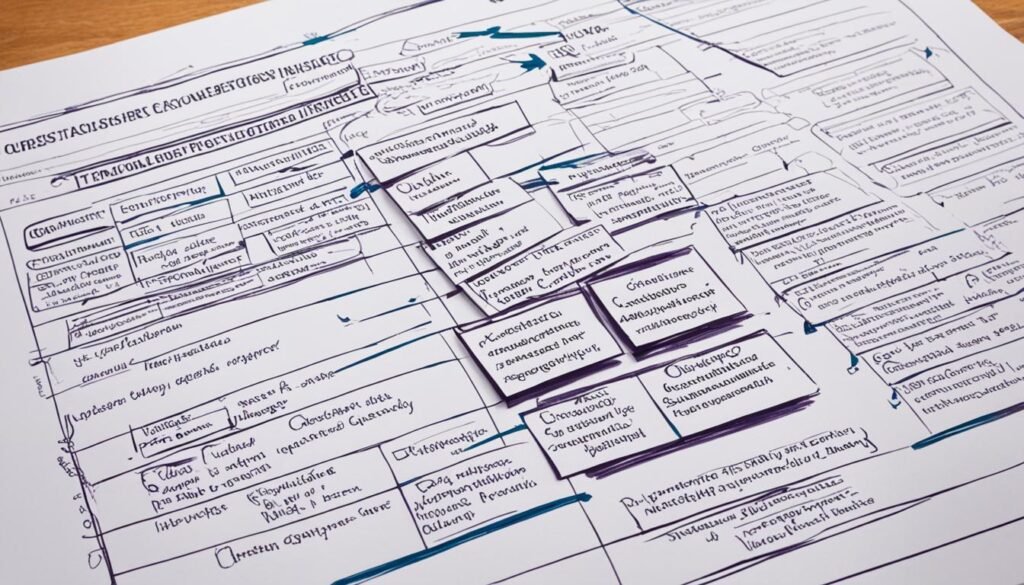Did you know the discovery phase in a personal injury lawsuit can involve up to 25 interrogatories? This stage is key for both sides to get the info they need for a strong case. It’s vital for anyone going through a personal injury claim to grasp this phase well.
In the discovery phase, both sides gather facts and important documents like accident reports and medical records1. They also exchange questions and sworn statements. This helps build a clear picture of what happened and supports a strong legal plan. Private talks with your lawyer or doctor are kept safe during this time to protect sensitive info1.
Depositions are a big part of discovery, where you give sworn testimony about the accident1. This testimony might be checked against what you say in court if the case goes to trial. So, the discovery phase is very important for getting your case ready.
Key Takeaways
- The discovery phase is a key stage in a personal injury lawsuit where both sides collect facts and evidence about the case.
- Important documents such as accident reports, medical records, and pay stubs are exchanged during discovery.
- Depositions, where sworn testimony is provided about the accident, are a key component of the discovery process.
- Confidential conversations, such as those between the individual and their lawyer or doctor, are protected during discovery.
- Understanding the discovery phase is essential for navigating a personal injury claim successfully.
Understanding the Discovery Process in Personal Injury Cases
The discovery phase is key in personal injury cases. It’s when both sides share and get information to plan their legal moves. Types of discovery tools like interrogatories, document requests, and depositions are used. These tools help make the legal process clear and fair.
Types of Discovery Tools in a Personal Injury Case
Interrogatories are written questions that lawyers use to get important details. This includes things like contact info, insurance details, and what happened in the accident2. Requests for production let both sides share evidence, like medical records and accident photos2. Requests for admissions help speed up the case by getting the other side to agree or deny certain facts2.
The Purpose and Process of Depositions
Depositions are when people involved in the case answer questions under oath2. This info helps lawyers plan their strategy and negotiate settlements2. In California, you must file a personal injury lawsuit within two years of the accident. The discovery phase can last from six months to a year3. Lawyers can ask up to 35 interrogatories, and they must answer within 30 days3.

“The discovery process aims to ensure all relevant information is shared, creating a transparent and fair legal process.”
Depositions, the last part of discovery, happen under oath and can be recorded3. The Tiemann Law Firm has helped many with injury cases and has gotten great feedback from clients3.
Interrogatories: Gaining Insights Through Written Questions
Interrogatories are key in the discovery phase of a personal injury case4. They let one party ask the other detailed questions in writing4. These questions can reveal new info, leading to more investigation and finding crucial evidence4.
Often used in civil lawsuits, interrogatories are common in cases about contract breaches or negligence4. They can have subparts for complex questions4. Unlike depositions, which are oral, interrogatories are written and are valuable tools for discovery4.
In Texas, interrogatories are vital during the discovery phase of personal injury lawsuits5. They help find out details like what happened, how bad the injury is, and if there were similar incidents before5. The info from interrogatories can sometimes lead to settlements or help focus on trial issues5.
Interrogatories aren’t just for personal injury cases. They’re also used in contract disputes, property damage cases, and cases about harmful products5. The answers to these questions help lawyers plan for trials, understand the other side’s defenses, and use as evidence if the case goes to trial5.
CloudLex, a cloud-based software, makes managing civil litigation easier, especially in personal injury cases4. Interrogatories are key for gathering info in civil cases, and CloudLex helps attorneys use this tool well4.

Overall, interrogatories are a strong tool in the discovery phase of personal injury cases4. They provide valuable insights and help in finding a successful resolution4. By using the info from interrogatories, attorneys can strengthen their case and help their clients get the best outcome4.
Personal injury discovery phase: The Significance of Document Production
The discovery phase in a personal injury lawsuit is key. It’s when both sides gather and share important info and evidence. A big part of this is document production6. This means sharing things like medical records and accident reports that help prove the case6.
Understanding the Importance of Document Production
Document production is very important in personal injury cases. It lets both the plaintiff and the defendant look closely at the evidence. This evidence is key in making a strong case6. These documents show the injuries, what happened, and how it affected the injured person6.
Getting and looking over these documents takes a lot of work. Both sides have to meet deadlines for this6. Many cases settle during or after this phase to avoid trial costs and stress6. If it doesn’t settle, it goes to trial. Then, a judge or jury decides who was at fault and how much to pay the injured person6.
The main goal of the discovery phase, including document production, is to make sure the case is fair and just6. By looking at all the documents, both sides can see what they’re up against. This leads to a better understanding and a fairer outcome7.
| Discovery Phase Metrics | Percentage/Timeframe |
|---|---|
| Personal Injury Lawsuits Settling During/After Discovery | 7Many personal injury lawsuits conclude either during or at the end of the discovery phase. |
| Timeframe for Discovery Process | 7The length of the discovery process varies depending on the case’s specifics; it may take weeks or months for lawyers to review all documentation. |
| Tools Used During Discovery | 7Lawyers have several tools available, such as depositions, requests for documents, and written interrogatories to gather evidence in personal injury cases. |
In summary, document production in the discovery phase is key in personal injury lawsuits. By sharing and looking at documents, both sides can build a stronger case. This leads to a fairer and more informed outcome67.
The Role of Expert Witnesses and Requests for Admission
The Role of Expert Witnesses in the Discovery Process
In personal injury cases, expert witnesses are key during the discovery phase. They include medical doctors or engineers who share their specialized knowledge. This knowledge helps explain complex issues related to the case8. Their opinions can make the case stronger by shedding light on the medical or technical aspects of the accident or injury8.
Identifying and preparing expert witnesses happens during the discovery phase. This is because their input is crucial in personal injury lawsuits9.
Admissions and Denials: The Importance of Requests for Admission
Requests for admission are vital in the discovery phase of a personal injury case. They ask parties to admit or deny certain facts, making the case simpler for trial8. This focus on key disputes helps both sides prepare better and use their time and resources wisely8.
These requests can also aid in settlement talks. They help identify what both sides agree and disagree on, which might lead to a settlement before trial10.
During the discovery phase, objections and motions are also crucial. They let parties challenge questions or get court decisions on certain issues. This ensures the process is fair and relevant8. This back-and-forth is key in shaping the case’s direction and outcome9.
“The discovery phase in personal injury cases is a critical stage where both sides work to gather and assess the evidence that will be presented at trial. Expert witnesses and requests for admission play vital roles in this process, helping to clarify the facts, streamline the lawsuit, and build a stronger case.”
| Discovery Tool | Purpose |
|---|---|
| Interrogatories | Written questions to the opposing party to gather information |
| Requests for Production | Asking the opposing party to provide relevant documents and evidence |
| Depositions | Oral interviews of parties, witnesses, and experts under oath |
| Requests for Admission | Asking the opposing party to admit or deny specific facts about the case |
Conclusion: Navigating the Discovery Phase Effectively
Navigating the discovery phase in a personal injury lawsuit means being well-prepared and organized. You need to gather all important documents like medical records and accident reports. Being ready for things like depositions is key, where telling the truth clearly is crucial. Knowing about discovery tools like interrogatories, depositions, and requests for admission helps you prepare better and boosts your chances of winning11.
The discovery phase is a key part of a personal injury lawsuit. It can greatly affect the case’s direction and outcome. It can take years, making it the longest part of the lawsuit12. Working closely with your lawyer and being honest and thorough can help you get through this phase well. Listening to your lawyer’s advice, like about social media, can also help during the discovery phase12.
To effectively navigate the discovery phase of a personal injury lawsuit, you need to understand the process well. This includes knowing about the different discovery tools and their roles. By preparing, organizing, and taking an active part in the legal process, you can increase your chances of a good outcome. This way, you can get the compensation you deserve.
FAQ
What is the discovery process in a personal injury lawsuit?
What are the different tools used during the discovery process in a personal injury case?
What is the purpose of interrogatories in a personal injury case?
Why is document production important in the discovery phase of a personal injury lawsuit?
How do expert witnesses and requests for admission contribute to the discovery process?
Source Links
- https://www.juanlaw.com/personal-injuries/what-happens-discovery-phase/
- https://www.oal-law.com/blog/understanding-the-discovery-process-in-a-personal-injury-case/
- https://tiemannlawfirm.com/what-is-the-discovery-phase-of-a-personal-injury-case/
- https://www.cloudlex.com/glossary/what-is-an-interrogatory/
- https://clewislaw.com/what-are-interrogatories/
- https://www.kff-law.com/what-is-the-discovery-phase-in-a-lawsuit/
- https://www.injury-attorneys.com/blog/what-happens-in-the-discovery-phase/
- https://www.charbonnetlawfirm.com/personal-injury-attorney/discovery-process-personal-injury-lawsuit/
- https://maxeymcfarlandlaw.com/blog/discovery-phase-in-personal-injury/
- https://thetorresattorneys.com/resources/blog/the-discovery-process-in-a-personal-injury-case/
- https://alanripka.com/understanding-the-discovery-process-in-personal-injury-lawsuits/
- https://www.blockotoole.com/personal-injury-lawsuits/discovery/

